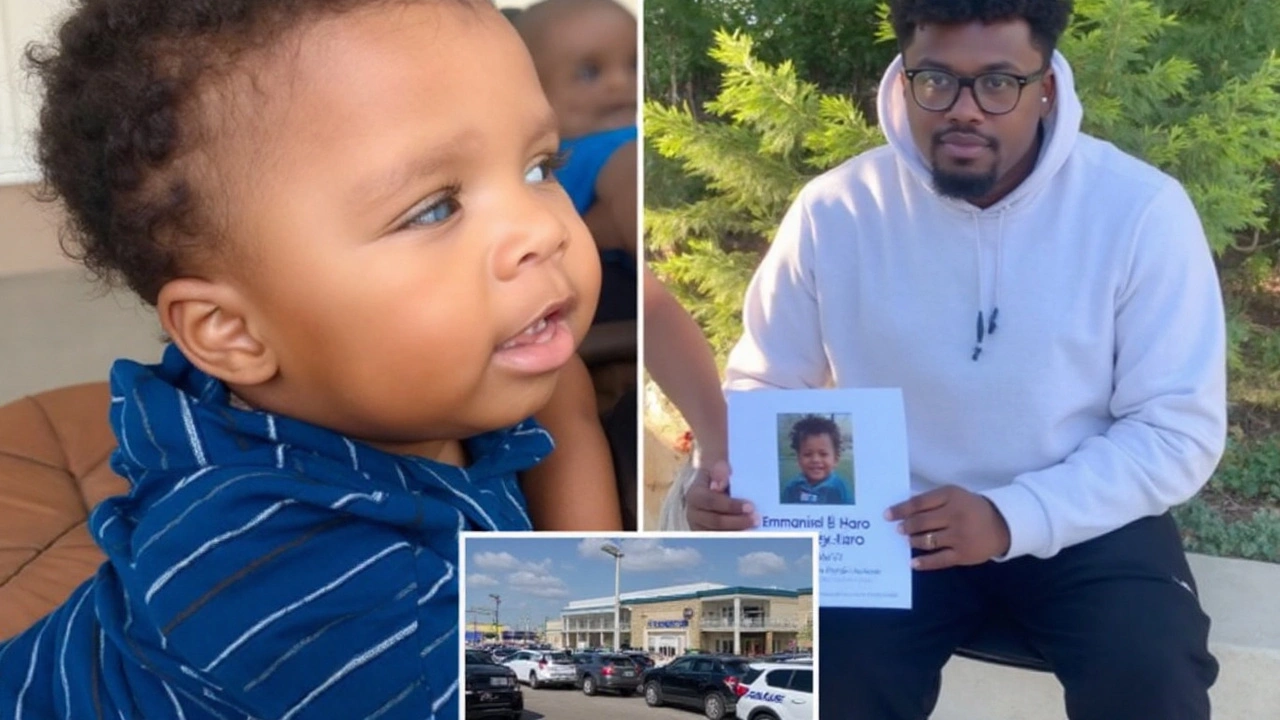A shifting timeline: From parking lot assault to homicide arrests
The search began with a frightening claim: a 7-month-old snatched from a parking lot. Seven days later, the story collapsed under evidence, and the boy’s parents were in handcuffs on murder charges. That arc—swift, public, and wrenching—now defines the case of Emmanuel Haro.
Emmanuel was reported missing on August 14 at about 7:47 p.m. in Yucaipa, a city in San Bernardino County. His mother, 41-year-old Rebecca Haro, told deputies she was changing her baby’s diaper outside her vehicle near a Big 5 Sporting Goods on Yucaipa Boulevard when an unknown man attacked her. She said she was knocked unconscious, and when she woke up, both the attacker and her infant son were gone.
Detectives treated the report as an emergency. They canvassed the area, pulled surveillance footage from nearby businesses, and brought in specialized search teams. As they pressed the mother for details, they found contradictions in the timeline and key parts of her account. During follow-up interviews, investigators said they confronted Rebecca with those inconsistencies. She then declined to keep talking.
That refusal mattered. Early missing-child cases often hinge on cooperation from those closest to the child. Investigators said the inconsistencies and the loss of cooperation meant they could not rule out foul play. Still, they continued to search widely, asking the public for tips and pleading for information. At one point, officials publicly urged the parents to help—“You will be protected,” they said—an appeal that signaled both urgency and doubt.
The break came eight days later. On August 22, San Bernardino County Sheriff’s investigators arrested Rebecca and her husband, 32-year-old Jake Mitchell Haro, at their home in Cabazon. Both were booked on charges of felony murder with malice. In announcing the arrests, the sheriff’s department said the evidence showed a kidnapping in Yucaipa did not occur.
That statement reframed the entire case. What began as a suspected stranger abduction had become a death investigation focused on the child’s parents. The department added another grim update: they believe Emmanuel is deceased. The search is now about finding his remains and establishing what happened, when, and where.
Investigators spread out across multiple locations tied to the family’s movements and history. They served search warrants at the Haro residence and used scent-tracking dogs. The team collected and reviewed large volumes of security video from businesses and neighborhoods. Detectives also turned their attention to Moreno Valley, where searches were conducted in dry fields off the 60 Freeway near Gilman Springs Road—rugged terrain broken up by brush and dirt roads.
Over the weekend, in a scene that underscored the direction of the investigation, deputies brought Jake Haro to that Moreno Valley site. Wearing an orange jail jumpsuit, he accompanied investigators and cadaver dogs as they scoured the area. The sheriff’s department did not say what led them there, but search sites are often chosen based on time-stamped video, phone records, license-plate reader hits, witness statements, or GPS pings from vehicles and devices.
Despite the arrests, Sheriff Shannon Dicus said the mission is unchanged: find Emmanuel. “The circumstances surrounding this investigation are tragic and we will continue to search for Emmanuel,” Dicus said. He added that he trusts the justice system to hold the parents accountable if the evidence supports it.
Community members have tried to keep that focus, too. A vigil drew residents who lit candles, prayed, and left messages for a child most of them never met. People brought stuffed animals and flowers. Others have checked their home security cameras and shared footage with investigators. Many asked the same question: where is Emmanuel?

Inside the search — and what comes next
Missing-infant investigations move fast and pull in many types of resources. In Yucaipa and Cabazon, detectives worked alongside search-and-rescue units and canine teams trained in both live scent and human-remains detection. Those dogs can zero in on trace odors that humans cannot detect, even in open country and heat. The searches in Moreno Valley show investigators are willing to look far beyond the first scene to chase down leads.
Video review is another piece. Modern investigations often gather hours—sometimes days—of footage from storefronts, gas stations, traffic cameras, and home doorbells. Analysts map timestamps and landmarks to build a minute-by-minute timeline. In this case, investigators say that timeline undercut the reported kidnapping and pointed them elsewhere.
While detectives worked the ground, they also dug into the family’s history. Riverside County court records show that in 2018, Jake Haro pleaded guilty to willful cruelty to a child. The sheriff’s department also acknowledged deputies had previously responded to a separate child abuse call at a Moreno Valley home connected to the Haros. Details of that incident are sealed, but the link added context to why investigators moved quickly and treated the case with such caution.
Police officials have said they do not believe there are other suspects in the baby’s death beyond the parents. That doesn’t mean the case is closed to new information. It means that, based on what they have so far, their focus is on the two people already under arrest. If new evidence points elsewhere, detectives can widen the lens.
As for the legal track, “murder with malice” in California typically means prosecutors believe the defendants acted with intent to kill or with a conscious disregard for life. That’s a high bar, and it comes into play even before a trial, in charging and bail decisions. Prosecutors will weigh physical evidence, digital data, statements, and any forensic results that emerge from searches.
The parents are expected in court next week, where they’ll be formally advised of the charges and a judge will set the schedule for the case. Early hearings often bring new disclosures—at least hints—about the evidence. Prosecutors may lay out basic facts to justify holding the defendants, and defense attorneys may preview their arguments. Until then, the sheriff’s department says the priority remains the same: recover the child and preserve evidence in the field.
Here’s what we know so far, laid out by date:
- August 14, 7:47 p.m.: Emmanuel is reported missing in Yucaipa after his mother claims she was attacked and knocked unconscious while changing him outside a vehicle near a Big 5 Sporting Goods. Patrol units and detectives respond, and early searches begin.
- Midweek: Investigators interview the mother, identify significant inconsistencies, and say she later declines to continue the interview. Detectives review large amounts of surveillance video and expand searches.
- August 22: Detectives arrest Rebecca and Jake Haro at their home in Cabazon on suspicion of felony murder with malice. The sheriff’s department says evidence indicates the reported kidnapping did not happen.
- Weekend after the arrests: Search teams work a remote field in Moreno Valley off the 60 Freeway near Gilman Springs Road. Cadaver dogs are deployed. In custody, Jake Haro accompanies investigators at the site.
- Ongoing: The sheriff’s department announces it believes Emmanuel is deceased. Searches continue in multiple locations. Investigators say they do not believe there are other suspects beyond the parents. The couple is scheduled to appear in court next week.
The geography of this case spans two counties and three distinct settings. Yucaipa is where the initial report came in. Cabazon, in Riverside County, is where the parents live and where they were arrested. Moreno Valley is where search teams have been working large open spaces, a type of terrain that can hide evidence but also preserve it away from foot traffic and weather.
Cadaver dog deployments in a homicide probe can be crucial. These dogs are trained to detect the scent of human decomposition in complex environments—under brush, near water, or in heat-baked ground. If a dog alerts, investigators typically mark the location, photograph the area, and bring in forensic specialists to dig by hand. Even if nothing is found immediately, those alerts can steer the next round of searches.
Beyond the field work, detectives are likely reconstructing movements through technology. That can include analyzing cell tower records, GPS logs from vehicles, and app-based location data when available through legal process. When investigators say they reviewed "a large amount of surveillance video," they’re often cross-referencing that footage with those data points. The goal is a single, consistent timeline: where the child was last seen, where the parents went, and what happened in between.
One delicate part of any case like this is balancing speed and certainty. Family members and the public want answers right away. Detectives have to lock down facts that will hold up in court. That’s one reason statements can seem spare, even after dramatic developments like arrests. Every word becomes part of the record, and any error can be exploited later.
The human story hasn’t been lost in the process. At the vigil, people spoke softly about a baby they never met and a family they don’t know. They showed up anyway. That’s common in child-loss cases. Communities rally because it feels wrong to let a child be missing in silence.
Sheriff Shannon Dicus called the case "tragic" and told residents his agency would not stop searching. He also voiced confidence that the justice system would address accountability. That dual focus—finding Emmanuel and building a clean case—signals how investigators see their job now. Recovery efforts can produce critical forensic evidence, clarify the sequence of events, and support future testimony.
Authorities have not announced any involvement by outside agencies such as state investigators or federal partners, but it’s common for departments to share resources informally, especially when searches cross jurisdictions. If bigger teams are brought in later, it would likely be for specialized forensics, mapping, or additional canine units.
The sheriff’s department has also emphasized that they are not seeking other suspects at this time. That message can help calm speculation and reduce false tips. It can also sharpen the community’s help where it matters: video from the Yucaipa corridor the evening of August 14, sightings of the family vehicle around Cabazon earlier that week, or anything unusual near the Moreno Valley search zones. Even small details—an unfamiliar car parked along a dirt pullout, movement near brush at odd hours—can make a difference when matched against a developing timeline.
Meanwhile, the background on the parents will likely become part of the court record. The 2018 conviction for willful child cruelty involving Jake Haro will draw scrutiny from prosecutors and the defense. The separate child abuse call in Moreno Valley connected to the family may also surface in pretrial arguments, though what’s admissible will depend on how closely it relates to the facts of Emmanuel’s case and the rules of evidence.
For now, investigators say the case is a homicide probe centered on two defendants and a single overriding objective: find Emmanuel. The searches in Moreno Valley may continue, or they may shift as new data arrives. If the team develops a promising lead—an alert from a dog, a tip that checks out, a match from a surveillance time stamp—they will move quickly to secure and process the site.
Anyone who has worked these cases will tell you the same thing: the clock matters, but so does patience. Recoveries can take time. The ground gives up secrets unevenly. And when a child is involved, every step tends to be deliberate—methodical, documented, and double-checked.
As of this writing, the San Bernardino County Sheriff’s Department says Emmanuel’s parents are the only suspects and that the search for the child’s remains is ongoing. The couple is scheduled to appear in court next week to face the murder charges. Detectives, meanwhile, are still out in the field, following the evidence where it leads.





